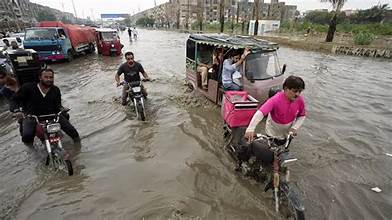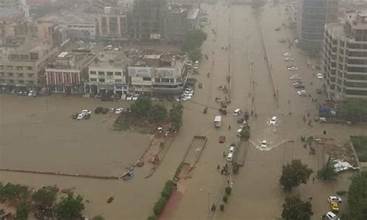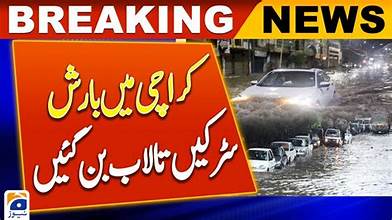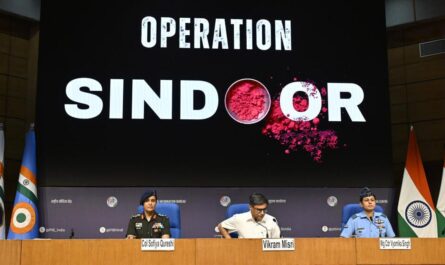Karachi, Pakistan’s largest metropolis and financial hub, once again found itself grappling with chaos as torrential rains lashed the city. What began as a welcome spell of monsoon showers quickly turned into scenes of urban flooding, paralyzed traffic, electricity outages, and widespread distress for millions of residents. Despite being a recurring problem every year, the city’s infrastructure remains ill-prepared to withstand heavy rainfall, leaving citizens to bear the brunt of mismanagement, clogged drains, and unplanned urbanization.
This latest episode of urban flooding highlights the deep-rooted challenges Karachi faces—problems that extend beyond a single rainstorm. From overwhelmed drainage systems to deteriorating roads and poor traffic management, the downpour exposed systemic issues that continue to disrupt the daily lives of citizens.
Streets Turned Into Rivers
As the skies opened up, key arteries of Karachi quickly submerged under rainwater. Major roads such as Shahrah-e-Faisal, II Chundrigar Road, and University Road were inundated, making them nearly impassable. Smaller residential neighborhoods faced even worse conditions, with knee-to-waist-deep water flowing through streets and seeping into homes. In low-lying areas, residents were left marooned, with vehicles abandoned in the middle of submerged intersections.
The situation was particularly grim in areas like Saddar, Korangi, and North Karachi, where outdated drainage systems could not handle the water flow. Citizens described scenes of chaos, as motorcyclists toppled on slippery roads, pedestrians waded through murky water, and shopkeepers rushed to save their goods from being destroyed.
Traffic Gridlock Adds to Misery
One of the biggest problems triggered by the rain was traffic congestion. With major intersections flooded, thousands of commuters were stranded for hours. Long queues of vehicles stretched for kilometers, and public transport virtually broke down in several districts. Schoolchildren and office-goers were stuck on buses, while ride-hailing services either suspended operations or charged exorbitant fares due to road conditions.
In some places, traffic wardens were seen directing vehicles through knee-deep water, but their efforts were overwhelmed by the sheer scale of the disruption. The lack of proper traffic management plans during monsoon spells remains a glaring failure that exacerbates Karachi’s mobility crisis.
Electricity Outages Create Double Trouble
Adding to the chaos, widespread power outages hit Karachi during the downpour. Many localities plunged into darkness as feeders tripped and electricity supply was cut to prevent accidents. Entire neighborhoods remained without power for up to 10 to 15 hours, worsening the suffering of citizens.
In several cases, residents expressed frustration at utility companies, complaining about the recurring problem of power cuts during rainfall. The outages also left drainage pumps inactive, further aggravating flooding in some areas. Without functioning pumps, water remained stagnant for days, posing health risks and breeding grounds for mosquitoes.
Urban Flooding: A Recurring Nightmare
Karachi’s struggle with urban flooding is not a new phenomenon. Each year, monsoon rains reveal the fragility of the city’s drainage system, much of which is clogged with solid waste or encroached upon by illegal constructions. Despite numerous promises by authorities, no long-term solution has been implemented.
Experts point out that Karachi’s rapid urban sprawl, unregulated construction, and poor waste management have worsened the problem. Natural stormwater drains (nullahs) that once carried rainwater to the sea have been encroached upon, reducing their capacity to handle heavy rainfall. As a result, even moderate showers now lead to severe flooding.

Health Concerns on the Rise
Beyond the immediate inconvenience, rain-induced flooding in Karachi poses serious public health threats. Stagnant water becomes a breeding ground for dengue and malaria mosquitoes, raising fears of disease outbreaks. Sewage mixing with rainwater also contaminates drinking water supplies, increasing the risk of cholera, diarrhea, and other waterborne illnesses.
Hospitals, already burdened with routine patient loads, brace for an influx of cases following monsoon rains. Doctors warn that without urgent preventive measures, Karachi could witness a spike in vector-borne and waterborne diseases in the coming weeks.
Citizens’ Resilience Amid Crisis
Despite the dire circumstances, stories of resilience and solidarity emerged. Neighbors helped each other evacuate water from homes, while local youth groups assisted stranded motorists and pedestrians. Social media was filled with citizens warning others of flooded roads, sharing alternative routes, and offering help to those stuck.
However, many Karachiites expressed deep frustration, lamenting that resilience has become a necessity rather than a choice. “We can’t keep adapting to failure,” one commuter said while stranded for three hours on Shahrah-e-Faisal. “This city deserves better planning and governance.”

Authorities’ Response and Promises
Authorities claimed they were monitoring the situation and deployed machinery to pump out water from key roads. However, many citizens reported that relief measures were slow and limited to main arteries, while residential areas were neglected. Political leaders, meanwhile, engaged in blame games, pointing fingers at past governments for the city’s condition.
For years, Karachi’s residents have heard promises of drainage upgrades, modern stormwater systems, and better disaster management—but implementation remains weak. Without long-term structural improvements, every monsoon season will continue to bring the same suffering.
The Need for Sustainable Urban Planning
Urban planners emphasize that Karachi cannot continue to rely on ad hoc solutions. The city needs a comprehensive urban resilience strategy, which includes:
- Revamping Drainage Infrastructure: Cleaning and expanding stormwater drains to ensure rainwater flows smoothly to the sea.
- Waste Management Reforms: Preventing garbage dumping into drains to avoid blockages.
- Traffic Management Plans: Creating alternative routes and improving public transport to prevent gridlocks during emergencies.
- Public Awareness Campaigns: Encouraging citizens to avoid dumping waste and to follow traffic guidelines.
- Green Spaces and Natural Solutions: Restoring wetlands and open spaces to absorb excess rainwater.
Unless such measures are prioritized, Karachi will remain vulnerable to floods and the cycle of suffering will continue.
Conclusion
The recent downpour in Karachi once again exposed the fragility of the city’s infrastructure and governance. Flooded streets, traffic jams, electricity breakdowns, and public health risks turned a natural weather event into a humanitarian crisis. While citizens showed resilience in the face of adversity, the responsibility to prevent such recurring chaos lies with policymakers and urban planners.
Karachi, a city of over 20 million people, deserves sustainable solutions, not short-term fixes. Until comprehensive reforms are implemented, each monsoon will bring with it the familiar woes of flooding, disrupted transport, and immense hardship for its residents.



